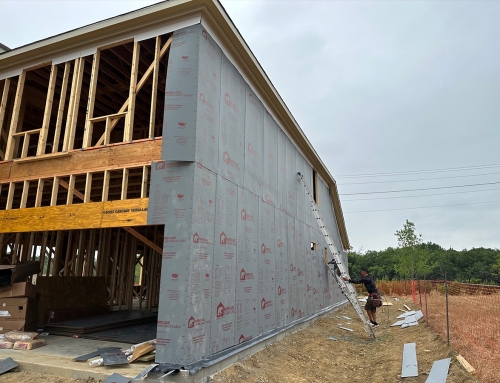A detailed house wrap inspection before applying the siding, by both the contractor and building owner, is critical to the house wrap’s performance. Improperly installed or damaged house wrap can lead to air and moisture intrusion to the wall system, which makes a building less energy-efficient, healthy, and comfortable.
To ensure a house wraps performance, building owners and contractors must conduct a detailed house wrap inspection for installation problems and any rips, holes, or tears.
Properly Installed and Undamaged House Wrap Controls Air and Moisture Infiltration
House wrap is a weatherization membrane made of a synthetic and lightweight material that goes over the sheathing and behind the siding (vinyl, wood, stucco, brick, or composite) of a building. When correctly installed and undamaged, house wrap creates a protective envelope against moisture and air infiltration into the wall cavity.
Accumulation of moisture within a building’s wall cavities can lead to wood rot (caused by fungi) and expensive repairs. Moisture can also initiate the growth of mold, which is unhealthy for the occupants of the building. Uncontrolled air infiltration lessens the effective R-value of the wall assembly and reduces the energy-efficiency and air quality of a building.
To minimize air infiltration and stop the accumulation of moisture within the wall assembly, the design of a high-performing building must include a properly installed and undamaged house wrap. It is critical to a building’s energy efficiency and indoor environmental quality to perform a detailed house wrap inspection before application of the siding.
What to Look for When Inspecting House Wrap for Damage and Installation Problems

-
Overexposure to the sun’s ultraviolet (UV) rays will damage house wrap.
When house wrap is left exposed to the sun’s UV rays past the manufacturer UV rating, it can discolor, photodegrade, and lose tensile strength and water repellency. Building owners should inspect installed house wrap for UV damage and make a note of the exposure time of the house wrap before application of siding.
Choosing a house wrap with a long UV-rating, like Barricade® Wrap, will reduce the likelihood of damage due to UV exposure. Barricade Wrap can tolerate four months of UV-exposure without damage occurring.
-
Detailed inspection of house wrap taping is essential to creating a continuous air barrier.
Proper application of the manufacturer’s recommended tape is critical to a continuous air barrier that will maximize energy savings for a building. Improper application of tape greatly diminishes a house wrap’s performance.
When inspecting house wrap tape for problems, building owners should ensure all seams, including the top and bottom edges, rough openings, and areas cut by subcontractors, are appropriately taped, with no adhesion problems or wrinkling.
Adhesion problems may occur if the application of the tape is over a damp or dirty surface or if the ambient temperature is too cold. Wrinkling and adhesions in the tape can lead to water and air intrusion. Also, fastener placement is essential to proper taping.
-
Repairing damaged house wrap is vital to preventing air and moisture intrusion.
Damaged areas of the house wrap will permit air and moisture to enter the wall assembly. Damage may happen due to rough handling or prolonged exposures to outside elements and construction debris. It is critical to seal and repair all tears, rips, and cuts to the house wrap before application of the siding.
Selecting a house wrap that resists ripping and tearing during installation due to its superb tear strength, like Barricade Wrap, will lessen the need to repair damaged wrap; saving both time and money.
-
Correct lapping of house wrap is crucial to a building’s energy efficiency.
Insufficient lapping of the house wrap can compromise water resistance from wind-driven rain. House wrap is most often installed from the bottom of the building up, overlapping the vertical joints by at least twelve inches and the horizontal joints by at least six inches. Also, the house wrap should extend over the footing top by at least two inches.
-
Inspect the house wrap around the windows and doors to prevent moisture intrusion.

Improper installation of house wrap around windows and doors can lead to moisture intrusion problems. Application of house wrap around the door or window openings involves a Y-cut from corner to corner in the openings. The excess material is then folded through the openings and fastened securely.
-
Look for the correct application of nails.
To properly hold down the house wrap, it is essential to apply nails every 12 to 18 inches with specific stapling nails.
A detailed house wrap inspection and the marking of any problem areas with a wide, black Sharpie, is critical to ensuring the performance of the house wrap. If a house wrap is damaged or improperly installed it can lead to moisture and air intrusion, reduced energy-efficiency, and compromised indoor environmental quality.
Please visit Barricade® Wrap for more information on reasons to inspect house wrap before application of siding.







